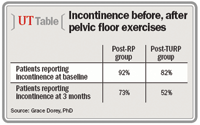Article
Pelvic floor exercises post-radical prostatectomy, transurethral resection of the prostate may have value
Pelvic floor muscle exercises (PFMEs) as a treatment for urinary incontinence after prostate surgery showed no significant difference in reduction of urinary leakage between intervention and control groups in a large multicenter study. Nevertheless, the randomized controlled trial still has a positive message about a role for pelvic floor muscle training considering that although men in the control group did not receive supervised training, some were also performing PFMEs and benefited with decreased urinary leakage.

Key Points
Glasgow, Scotland-Pelvic floor muscle exercises (PFMEs) as a treatment for urinary incontinence after prostate surgery showed no significant difference in reduction of urinary leakage between intervention and control groups in a large multicenter study. Nevertheless, the randomized controlled trial still has a positive message about a role for pelvic floor muscle training considering that although men in the control group did not receive supervised training, some were also performing PFMEs and benefited with decreased urinary leakage.

The randomized study, presented at the 2011 International Continence Society annual meeting in Glasgow, Scotland, was conducted at 34 centers in the UK and enrolled 853 men suffering from urinary incontinence at 6 weeks after their prostate surgery. The intervention arm included 205 men who had undergone prostatectomy for prostate cancer and 220 who were post-transurethral resection of the prostate (TURP). The control group received standard care.
"Most of the nurses and physiotherapists providing the training were not clinicians experienced in treating male incontinence, and only 85% of men in the RP group and 72% of the TURP patients received the maximum training per the protocol. Results from studies by Overgård et al [Eur Urol 2008; 54:438-48] and Van Kampen et al [Lancet 2000; 355:98-102] in men with post-RP urinary incontinence show there is value for treatment by an experienced specialist physiotherapist and for continuing the education program until men are dry," Dr. Dorey said.
"Furthermore, men in the control group receiving standard care could have received an educational leaflet describing PFMEs while in the hospital, and may have performed PFMEs if they suffered from severe incontinence and erectile dysfunction. In fact, at 1 year among control group patients, PFMEs were being performed by half of the post-RP men and 20% of those post-TURP."
In the intervention arm only, pelvic floor muscle strength was determined by digital anal assessment at each therapy session and graded using a 0 to 6 modified Oxford scale. Data were analyzed separately for the post-RP and post-TURP subgroups, and for both subgroups, about 35% to 40% of men achieved a grade 4 to 6 contraction (moderate to very strong) in assessments of both the anal sphincter and the puborectalis muscle at baseline. All of these proportions were more than doubled at the end of the 3-month training session.
The International Consultation on Incontinence Urinary Incontinence Short-Form questionnaire (ICIQ-UI SF) was administered at each therapy session to assess incontinence. In the intervention arm, 92% of men in the post-RP subgroup and 82% in the post-TURP subgroup reported incontinence at baseline, with stress urinary incontinence (SUI) being more common than urge urinary incontinence (UUI) among the post-RP patients (84% vs. 20%) and UUI more likely than SUI among the post-TURP men (57% vs. 36%).
Rates of incontinence decreased progressively at each therapy session, reducing to 73% in the post-RP subgroup and 52% for the post-TURP subgroup at the end of 3 months. The proportions of patients reporting both SUI and UUI also decreased in both the post-TURP and post-RP subgroups, and mean ICIQ-UI SF scores were consistent with the above results.
Drop in post-micturition leakage rates seen
Rates of post-micturition leakage decreased significantly from baseline to 12 months in the post-RP (63% to 25%) and post-TURP (57% to 33%) intervention subgroups. There were no significant differences comparing the intervention subgroups with their counterparts in the control group for any of these incontinence outcome measures.
Bowel disorders and sexual dysfunction were also investigated, but at 3 months, there were no significant changes in the proportions of patients in the intervention or control arms reporting either of these problems.
"This trial showed that a treatment with just a few pelvic floor muscle training sessions was not effective when compared to standard care. Further trials could use a pure control group and provide more intensive treatment to encourage men to continue their pelvic floor exercises until they are dry and to provide much needed ongoing support," Dr. Dorey said.
Newsletter
Stay current with the latest urology news and practice-changing insights — sign up now for the essential updates every urologist needs.
















